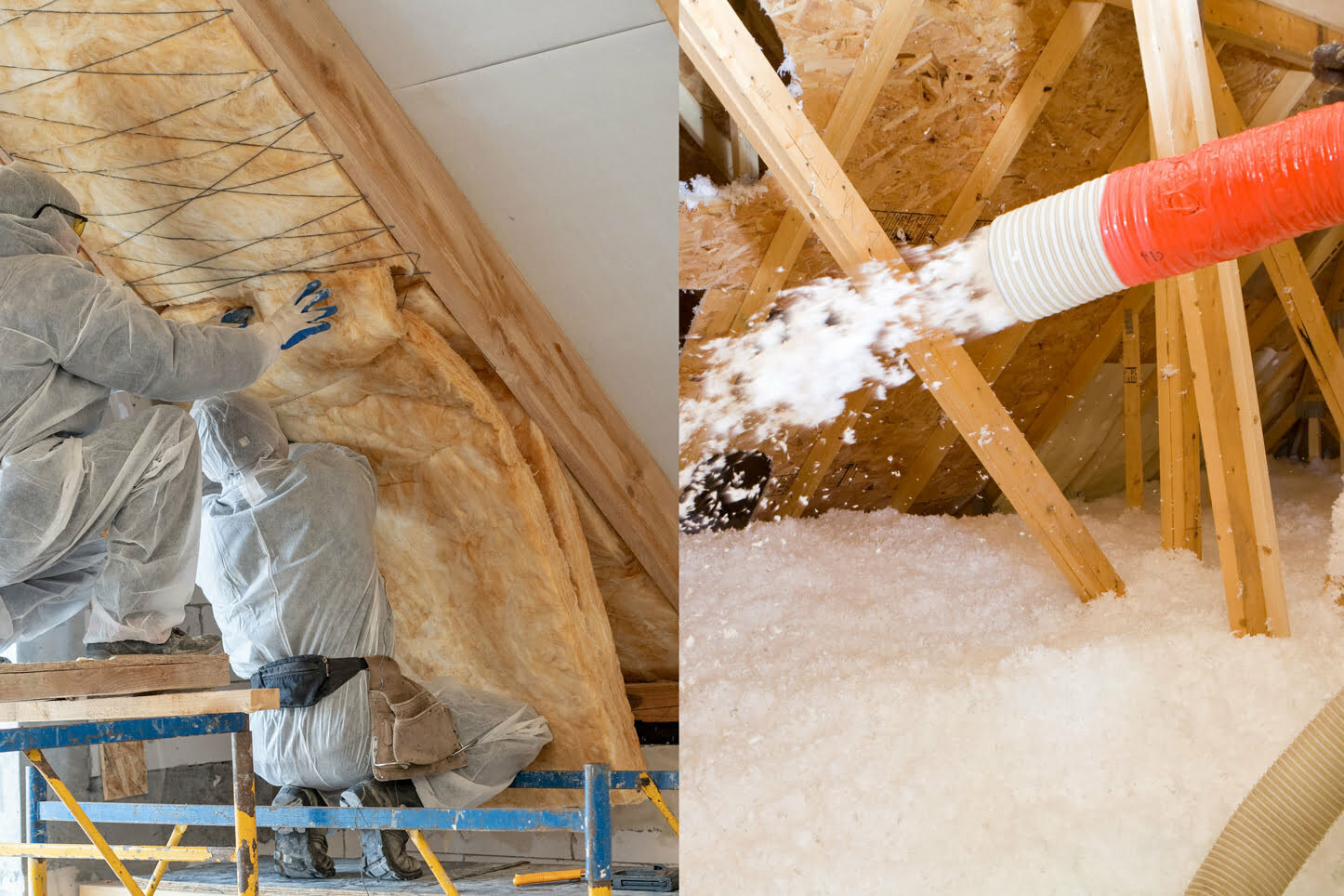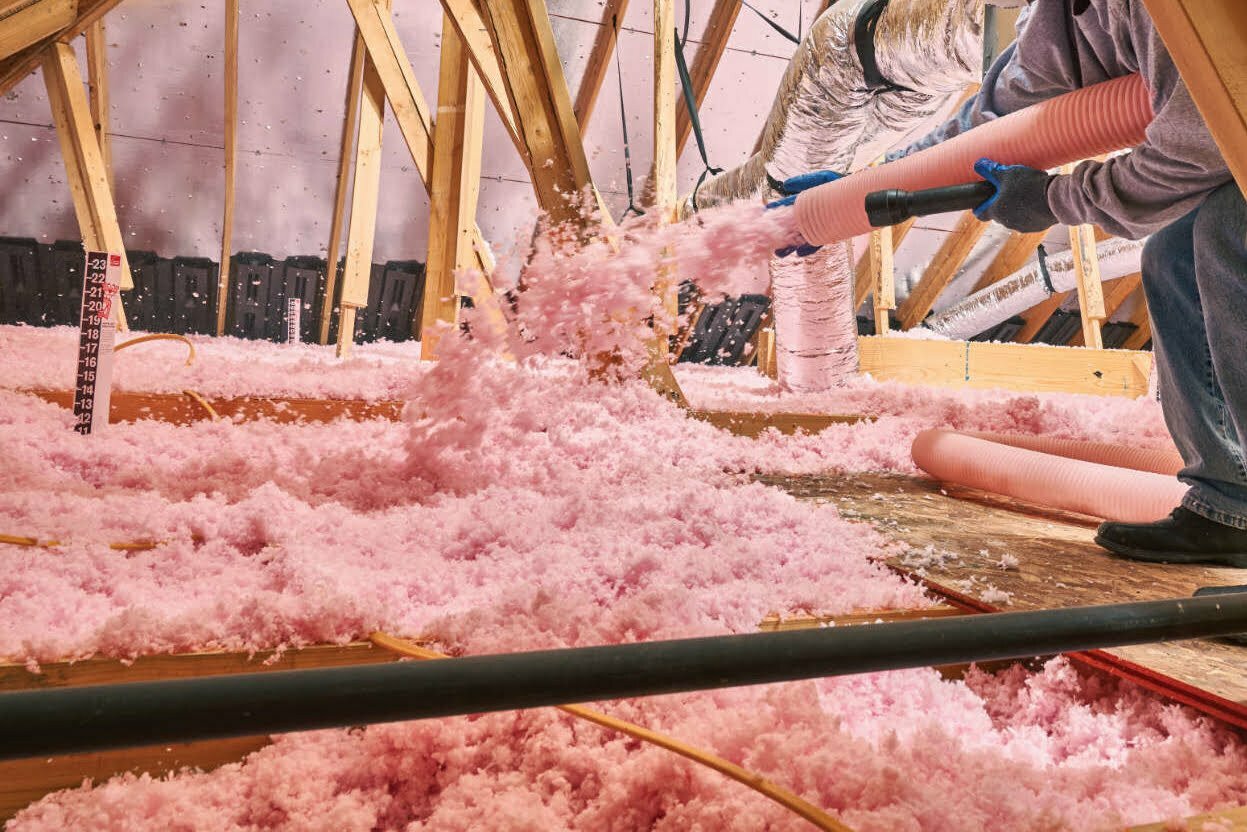Blown-in insulation is popular for homeowners seeking to increase their property’s energy efficiency. With blown-in insulation, you can limit heat flow, improve energy efficiency, and reduce ice dams. But how much is blown in insulation? And what should you know before investing in this service? Let’s dive into what you need to know.
Understanding Blown-in Insulation
Blown-in insulation, or loose-fill insulation, is a home improvement method that can significantly reduce your energy bills. Like other types of insulation, this product aims to improve the comfort of your space by better controlling extreme hot and cold temperatures.
What is Blown-in Insulation?
Blown-in insulation involves applying cellulose, fiberglass, or mineral wool insulation to your wall cavities, attic floor, and other stud spaces using a blowing machine. This type of insulation is particularly suitable for existing homes as it requires little structural alteration and can easily be installed on top of any existing insulation.
Types of Blown-in Insulation
There are primarily three types of blown-in insulation — cellulose, fiberglass, and mineral wool. Each type has unique benefits, insulation costs per square foot, and application methods.
Cellulose Insulation
Cellulose insulation cost can be slightly higher than other materials, but it offers excellent resistance to air leakage. It is usually sprayed into the wall cavities using a blowing machine, filling the spaces entirely.
Fiberglass Insulation
Fiberglass insulation consists of tiny particles of glass fiber. It has a lower cost and is excellent for adding insulation to exterior walls and attic spaces. The insulation material is blown into studs of the space you’re insulating to fill gaps, ensuring maximum energy efficiency. The price can vary based on square footage, labor, and any additional costs required for proper installation.
Mineral Wool Insulation
Mineral wool insulation, or natural wool blown insulation, is made from molten rock or metal slag. It’s an eco-friendly option that provides excellent fire resistance. Similar to spray insulation, it fills the wall or attic insulation spaces to strengthen the barrier against heat loss. The wall insulation costs for mineral wool can be slightly higher due to labor costs.
Benefits of Blown-in Insulation
There are a variety of reasons to consider blown-in insulation for your home. In addition to the insulation cost, these benefits should be considered when comparing quotes from different insulation contractors:
Energy Efficiency
Blown-in insulation increases the thermal performance of your house, which can significantly lower your energy bills. It prevents warm air from escaping during winter and hot air during the summer, reducing energy consumption for heating and cooling.
Reduces Ice Dams
This insulation helps reduce ice dams by maintaining a consistent temperature in your attic and preventing uneven melting and freezing of snow on the roof. By preventing heat loss from the home, blown-in insulation reduces the likelihood of ice dams forming and damaging your home’s roof or interior.
Easy Installation
Installing blown-in insulation is relatively quick and causes minimal disruption to your home activities. The insulation is blown into wall cavities or the attic floor, making the most out of the available space, whether it’s cellulose, fiberglass, or natural wool.
Factors Affecting the Cost of Blown-in Insulation
Determining the cost of blown-in insulation involves various factors, including the size of the area you’re insulating, the insulation material chosen, and labor price.
Size of the Area to be Insulated
The cost of blown-in insulation noticeably fluctuates based on the space you’re insulating. This can include wall cavities, stud spaces, attic floors, and exterior walls in existing homes. Usually, insulation costs are computed per square foot to account for the wide variety of home sizes and insulation needs. The larger the square footage, the higher the cost of installing blown insulation.
On average, attic insulation costs are less than wall insulation due to ease of access and less complicated installation process. This highlights the importance of obtaining multiple quotes from trusted local insulation experts to ensure you get the best deal.
Type of Material Used
There is no fixed price for insulation materials, as there is a wide variety to choose from. Fiberglass insulation, spray foam insulation, mineral wool, natural wool blown in, or spray cellulose come with differing costs.
Each material has pros and cons, widely affecting your home’s energy bills and insulation costs. For instance, foam insulation is very effective at filling wall spaces in existing insulation with a good R-value, but it comes with additional charges. Blown-in insulation has a different R-value that depends on the material used but is typically lower than spray foam. However, it still provides good insulation when properly installed.
Labor Costs
The labor cost of adding insulation varies based on the complexity of the job. Insulation contractors may charge different rates depending on their expertise, region, and supply of insulation materials. For example, if you have existing insulation that must be removed, this could add labor time, thus driving up the final cost.
Many homeowners underestimate labor costs in their insulation budget. It’s vital to understand what the job entails: tearing up old insulation, prepping the area, potentially working between wall framing, using the blowing machine, and cleaning up afterward. All these tasks influence the labor cost. It’s advisable to track these elements while discussing with insulation experts to know the average cost.
Estimating the Cost of Blown-in Insulation
The final cost of blown-in insulation depends on the insulation material you pick, labor costs, and the square footage of the space you’re insulating. And don’t forget about additional expenses that can arise along the process. Always remember to compare multiple quotes from trusted local insulation experts and make sure you understand what’s included in your insulation cost.
Average Cost of Material per Square Foot
Choosing an insulation material can impact your insulation costs significantly. It’s good to know that there is a wide variety of insulation materials. Common choices include spray foam insulation, cellulose insulation, mineral wool, and fiberglass insulation. For demonstration purposes, let’s break down the cost for a few of these materials per square foot. These are just examples and may not reflect accurate pricing of insulation from Cincinnati RetroFoam.
Let’s assume spray foam insulation costs around $1.00-$1.50 per square foot, while the cellulose insulation cost runs between $1.00 and $2.00 per square foot. Mineral wool can average between $1.00-$1.50 per square foot and fiberglass insulation can run between $0.70 and $1.00 per square foot. Remember, these are just the material costs and do not include labor costs or any additional supplies needed.
Typical Cost Range for Professional Installation
There’s a wide range of labor costs for insulation installation. It all depends on factors like the existing insulation (if there is any), the complexity of the installation, and whether your home has lots of stud spaces or wall cavities.
If you’re insulating a 1,000-square-foot attic, you can expect the labor cost to range from $1,000 to $2,000, in addition to your material cost. A trusted and experienced insulation contractor can assess the needs of your home and provide an accurate quote.
DIY vs. Professional Installation: Cost Comparison
You might be considering a DIY option to save money, but it’s crucial to understand what this involves. Blown-in insulation requires a blowing machine, which can be rented but is still an added expense. In addition, maneuvering the machine and properly distributing the insulation (especially if you’re adding insulation over existing insulation) can be difficult without the proper training.
Your final cost could be higher than you anticipated due to unforeseen challenges, damage to your home, or inadequate insulation, leading to higher energy bills. There’s also the issue of safety – insulating is not without risks, especially when dealing with attic insulation and climbing into wall framing and wall cavities. Air sealing is another crucial factor a professional can handle more efficiently, helping you achieve better energy efficiency in your home.
In short, while DIY might seem like a budget-friendly option at first glance, it might be more cost-effective in the long run to hire trusted local insulation experts. Professionals will come armed with experience and expertise, ensuring the job is done right the first time around.
Choose Cincinnati RetroFoam for Your Insulation
Since 2015, Cincinnati RetroFoam has offered premium insulation to homeowners that isn’t available anywhere else. Our mission is to provide impeccable service and give our best at every job so we can give homeowners comfort and long-term savings.
We offer a range of insulation services, including blown-in insulation, injection foam, and spray foam. We work on existing homes, new construction, pole barns, and commercial properties. Whatever your insulation needs are, we’re here to help. We also offer financing options if you’re looking for ways to manage insulation costs. Let us serve as your trusted partner for your upcoming insulation project. Contact us today to get your free quote.
Frequently Asked Questions
What is the life expectancy of blown-in insulation?
When installed properly, blown-in insulation can last 20-30 years, providing increased comfort throughout your home.
Is blown-in insulation worth it?
Blown-in insulation can be a smart investment providing you long-term comfort in your home. It’s important to work with qualified installation experts so the job is done right and will last for decades.
Can an attic have too much insulation?
Yes, an attic can be over-insulated and trap moisture. However, if you invest in professional insulation services, you can avoid this problem.


